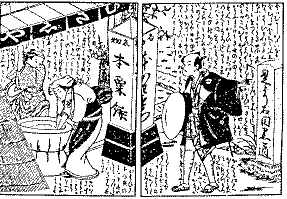The Salad Bowl.
Vol. VI, No. 1. Jan. 1998. p. 1 - 4. (Shizuoka Profiles)

Koikawa Harumachi
During the mid-Tokugawa era when Japan was at relative peace, many samurai strove to sharpen their literary talents as well as fighting skills. One individual who excelled as a ukiyoe teacher, author of many satirical works, and creator of an entirely new art form known as kibyoushi was Koikawa Harumachi.
Born in Shizuoka in 1744 as the second son of a samurai from the Kishu domain, little is known about Koikawa's youth. It is believed he lived in the Kojima district of Shizuoka with the Kurahashi family, who were vassal retainers for the powerful Matsudaira family.
In 1767 Koikawa was adopted by Kurahashi Katsumasa, a wealthy samurai. Soon after this he moved to a suburb of Tokyo. Koikawa worked as a guard for the Matsudaira family and in his free time studied painting under Katsukawa Haruaki.
In 1775 Koikawa produced his first comic book - a profusely illustrated text with a yellow cover and hiragana text on both front and back. This type of work became known as kibyoushi and over the next two decades Koikawa created some 29 different kibyoushi texts.
One of Koikawa's more popular works was Kinkin Sensei Eiga no Yume (tr. Prof. Kin-kin's Dream). In this short story, a young man visits a fashionable rice cake shop and imagines being adopted into a rich family. In his dream, the young man enjoys an extravagant life until his foster parents become fed up and disown him. . . . Though part of this story was based on a contemporary Chinese story, some parts appear autobiographical. Certainly Koikawa was adopted into a rich family and his foster parents circumcised his behavior.
Adopting Sakanoue Furachi as a nom de plume, Koikawa wrote a number of satirical comedies in Edo. He ridiculed contemporary figures, pushing the limits of the shogunate censors. Koikawa's parodied many human foibles. In this sense, he ranks with Kitagawa Utamaru and Heironymus Bosch in his ability to transform the eccentric and absurd into art.
Koikawa continued producing numerous ukiyoe prints and witty satires until 1796, when his final work was published. Oomukaeshi Bunbu Nido (tr. A Parrot's Account of the 'Path of the Sword' and the 'Path of the Pen') was a brilliant political satire. Using crested parrots as a metaphor, Koikawa showed how shogunal officials could repeat phrases without understanding what their meaning. Not surprisingly, this book was banned and Koikawa was summoned to appear before shogunal authorities. Bed-ridden by then, Koikawa never appeared before court. Koikawa may have written this book with the knowledge he had a terminal disease. At any rate, he died on July 7, 1796. A rumor spread that he committed suicide. The truth, however, is unknown.
Though Koikawa was active for only two decades, he produced many fine comic books and witty stories. He also inspired artists such as Yomono Akara and Tegara Okamochi. Koikawa never achieved the same level of fame as Andoh Hiroshige or Toushuusai Sharaku, but still he was still a highly gifted artist.
- Tim Newfields

www.tnewfields.info/sb/koi.htm
Copyright (c) 1998 by Tim Newfields and the Shizuoka City International Association
